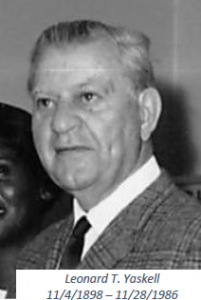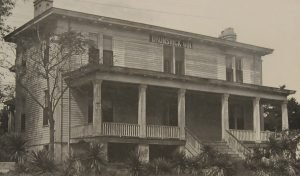Category: Uncategorized
L. T. Yaskell Tells His Story
L. T. Yaskell Tells His Story
Prepared by: Bob Surridge
Hello, my name is Leonard Thadeus Yaskell…L. T. to my friends and Leonard to my wife, Louise, and, Uncle Leonard, to our lovely niece Gwendolyn. Those of you native to Southport know Louise as Louise Standland. Louise and I did not have children, but we were very involved in Gwendolyn’s life. Gwen’s mother was Louise’s older sister, Alneta. Alneta died in December 1915, when Gwendolyn was just one year old. Gwendolyn was always a joy and Louise and I were so proud when she named her daughter Alneta after her mother.
I was what people now call a “Newcomer.” I made my way to Southport shortly after World War I. I was a Marine corporal and commanded a gun crew on the cruiser USS Charleston. During my time on the Charleston, we did escort duty in the Caribbean. We also made two convoy voyages to France during hostilities and later took occupation troops to France and then brought combat veterans home.
But, I’m getting ahead of myself. I was born in 1898 in Wilkes-Barre, Pennsylvania. My father was Michael (Micha) Yatskoslavage. He came to America from Poland in 1888. My mother Mary, who was 10 years younger than my father, came in 1890. They were married in 1893. I had two older brothers Brunslaw (Bernard) and Adam, plus two younger sisters (Matilda and Stacy). My father was a coal miner. He worked in the hard coal (anthracite) mines, mines that go hundreds of feet underground. The men would say: “I no speak English, hard work…any job!”
Life was very difficult for immigrants in the coal regions and many stayed just a short time before returning to Europe. Did you know that, when my parents came here there was virtually no such thing as “illegal” immigration… anyone who was healthy and not a criminal was allowed into the country. Once here, the “hunkys” (as they called us), both men and boys…went to work in the mines 10-12 hours a day. It was a hard life, which was made more difficult because the people who came to America before us did not like us…they said we were dirty and ignorant…lower class…not worthy to be Americans…even the head of the U. S. Immigration Service said that we were not mentally and socially as good as the earlier immigrants. Many people said we were ruining American culture. In fact, in the 1921 and 1924, congress passed quota laws designed to keep Polish, Italian, Hungarian and other immigrants from central and southern Europe out of the country.
So, you’re thinking how did I get to Southport? Well, like I said, I was born in Wilkes-Barre, PA and like most sons of miners, I spent some time working in the mines. Then a friend told my father about St. Helena, North Carolina, where Mr. Hugh MacRae was selling 10 acre farms for $240…$90 down and the rest in equal payments over three years. Seeing this, my father and mother made the decision to go to St. Helena. Unfortunately, my father died (perhaps because of black lung disease) shortly after we arrived in NC, but with myself and all my brothers and sisters working with mother…we made our dairy farm work. I eventually took a job as a salesman for the Carolina Trucking and Development Company. And, it was that job that brought me to Southport in the early 1920s. Back then Southport was a dusty, windblown pogie fishing village. Sometimes the odor from the pogies would be terrible, but what Southport founder Joshua Potts called “salubrious breezes” took away the odor.
In Southport, I found some of the prettiest girls I’d ever seen. One in particular, Louise Standland caught my eye and my heart. Louise and I married in 1921 and took a house on Caswell Street. We started a grocery store and ran it together. By 1927, we were well enough off that I spent a term as the mayor of Southport. In January, 1929, Louise and I packed up our Essex sedan and made a month long trip to Wilkes-Barre, Pennsylvania to visit family and friends. Louise was shocked to learn that I had about as many relatives as there were people in Southport!
Over the years, I developed a strong interest in politics and public service. In addition to serving as the mayor of Southport, I also served as the Chairman of the Brunswick County Board of Commissioners. Then in 1935, President Franklin Delano Roosevelt appointed me to be Southport’s Postmaster. I was postmaster until 1945. However, I think my proudest time in public service came in 1939 during my tenure as chairman of the hospital’s Board of Trustees, when the Brunswick County Hospital was renamed the J. Arthur Dosher Memorial Hospital.
In the late 40s, Louise and I moved to New Jersey to help my mother and brothers run the Brick Church Restaurant in East Orange, NJ. The restaurant was near the Brick Church commuter train station that took workers to and from New York City. Location, location, location. The restaurant was very successful and we stayed in New Jersey until I retired in the early 1960s and we then returned to Southport. At that time, I was able to pick up my work with the Board of Trustees of the hospital. In 1980, I was honored to be asked to cut the ribbon at the opening of the new Southport Post Office.
As you can tell, I lived a long and I believe successful life. And, I enjoyed every minute of it. I just hope the people of Southport think I helped make Southport a better place to live.
Tony Caseletta & Old Brunswick Inn
Tony Caseletta & Old Brunswick Inn
Liz Fuller, Southport Historical Society
The Old Brunswick Inn, currently a private home, is located on the corner of Bay and Atlantic (across the street from the Walker-Pyke house). Like many old Southern homes, the Brunswick Inn is said to be inhabited by a ghost. It is said that while the body of Tony Caseletta lies buried in Old Smithville Burying Ground, his spirit resides at the Inn.
Tony is said to be a friendly spirit who contents himself with hiding hairbrushes, jewelry, or other small items and occasionally slamming shut an open window. Those who are lucky hear him play a few strands of harp music in the middle of a moonlit night.
In life, Tony was a musician. He played the harp for guests at the Brunswick Inn while they danced in the adjoining ballroom. One night in 1882, following dinner, the 20-year-old harpist decided to go for a sail on the river. He kissed his bride and their infant son goodbye and then joined a few friends on a small boat that was “frequently used by pleasure parties at Smithville.” The boat was ballasted with iron. When a problem arose with letting go of the sails, the boat capsized, and the heavy iron caused it to sink directly to the bottom of the river, “nearly opposite the hotel and but a short distance from the shore.”
Some say that Tony’s presence continues to reside at the Inn because he was simply too much in love – with his wife, his child, his music, and with life itself, to let it all go so soon. Instead, he lingers on at this beautiful spot on the Cape Fear, playing his music and reliving his happiest days.
The Old Brunswick Inn, 301 E. Bay St., is now a private residence, but you can still wave at Tony as you pass by!
Southport and the War over Watermelons
Southport and the War over Watermelons
Liz Fuller, VP Southport Historical Society
One of the differences between a soldier and an officer, is that an officer needs to learn to choose his battles carefully. Otherwise, it’s possible to win the battle but lose the war. Such a story happened at Fort Caswell in 1911 when Captain Howard L. Landers decided to go to battle with a local Southport farmer over the price of watermelons.
It seems that this farmer, 26-year-old Wallace Moore, was in the habit of selling watermelons to the men stationed at the fort. He would load up a boat with the melons and row them out to Caswell. Once there, he charged a little bit more than what he would sell them for in Southport — a convenience fee, if you will.
On one hot July day, Captain Landers, Acting Commander of Fort Caswell, decided to put an end to what he perceived as price gouging. He told Moore that he would only permit him to sell his melons at the fort if he charged 25 cents apiece. Since Moore had already gone to all the trouble of rowing his crop to the fort, the farmer decided he might as well go along with that plan.
A little while later, Capt. Landers was informed that Moore was selling the melons for 40 cents rather than 25 cents. Incensed at this insolence, Landers ordered that Moore be detained until he could speak to him. Later, Landers would testify that his men had gotten a little over-zealous in carrying out his order. He hadn’t actually meant for Moore to be thrown into the brig. And Moore would testify that he had never over-charged for the melons. He had simply tacked on a delivery fee for toting the melons from the boat to the officers’ quarters.
Unfortunately, by that afternoon when Moore was finally released from the brig, neither man was in a conciliatory mood. Furiously, Moore rowed back to Southport and headed straight to the office of one of the town’s lawyers.
And just like that, a letter was sent to Senator Lee Overman in Washington, D.C. From there, Sen. Overman lodged a complaint with the military. And in less time than it took to slice a watermelon, Capt. Landers was served with a court-martial.
The trial took place in Wilmington and lasted three days. Nine military officers heard the case. The juicy story was picked up by papers from NY to Boston and from DC to San Francisco. Sides were quickly drawn. It seems everyone had an opinion on the watermelon war.
In the end, Landers was acquitted of the charges. But the trial left a bad taste in everyone’s mouth. Both the captain’s reputation and the military’s relationship with the town had been damaged.
A few weeks after the trial ended, Captain Landers, no longer the acting commander of the fort, had business in Southport. As Landers was walking up the courthouse steps, he had the misfortune of running into the father of Wallace Moore. The old man was still enraged over the insult that had been done to his family. In his fury, he took a swing at the much younger captain.
Luckily for both, Southport’s Mayor, Price Furpless, was standing nearby. The mayor jumped into the fray, quickly pulling the farmer away, causing his punch to miss its mark. It was then that Captain Landers proved that he had finally learned to choose his battles wisely – he beat a quick retreat.
This hard-won wisdom would continue to serve Landers well throughout his military career. Already a veteran of the Spanish-American war, Landers continued to serve in the army, including fighting overseas in World War One. He ultimately retired from service, with the rank of colonel. He passed away in 1966, having lived to the ripe old age of 92. Even in his later years, it’s likely Landers never forgot his first command at Fort Caswell, and his unfortunate decision to wage a war over watermelons.
Southport farmer, Wallace Moore, also lived to the age of 92, passing away in 1978. Moore was both a grandfather and a great-grandfather. It’s likely that every time his family sat down to enjoy a slice of watermelon, Grandpa would take the opportunity to regale them with the story of how he’d once taken on the powerful United States Army. While it was true he’d lost the battle, by standing up for his dignity, he had most certainly won the war.





